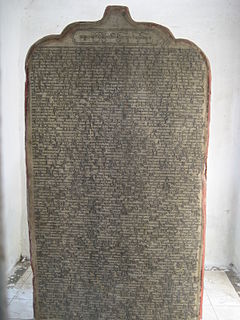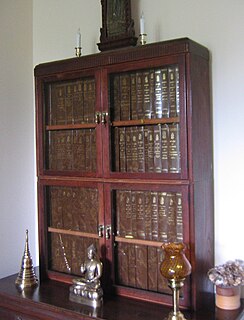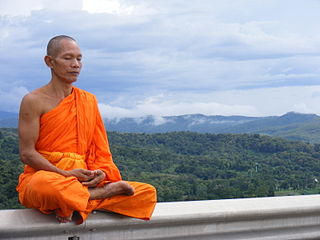
Buddhaghosa was a 5th-century Indian Theravada Buddhist commentator, translator and philosopher. He worked in the Great Monastery (Mahāvihāra) at Anurādhapura, Sri Lanka and saw himself as being part of the Vibhajjavāda school and in the lineage of the Sinhalese Mahāvihāra.

Nikāya is a Pāḷi word meaning "volume". It is often used like the Sanskrit word āgama to mean "collection", "assemblage", "class" or "group" in both Pāḷi and Sanskrit. It is most commonly used in reference to the Buddhist texts of the Sutta Piṭaka but can also refer to the monastic divisions of Theravāda Buddhism.

Buddhist texts were initially passed on orally by monks, but were later written down and composed as manuscripts in various Indo-Aryan languages which were then translated into other local languages as Buddhism spread. They can be categorized in a number of ways. The Western terms "scripture" and "canonical" are applied to Buddhism in inconsistent ways by Western scholars: for example, one authority refers to "scriptures and other canonical texts", while another says that scriptures can be categorized into canonical, commentarial and pseudo-canonical. Buddhist traditions have generally divided these texts with their own categories and divisions, such as that between buddhavacana "word of the Buddha," many of which are known as "sutras," and other texts, such as shastras (treatises) or Abhidharma.
The Sutta Pitaka is the second of the three divisions of the Tripitaka or Pali Canon, the Pali collection of Buddhist writings of Theravada Buddhism. The Sutta Pitaka contains more than 10,000 suttas (teachings) attributed to the Buddha or his close companions.

Theravada Buddhism is the State religion of Sri Lanka practiced by 70.2%. Buddhism has been given special privileges in the constitution and also declared country's official religion by 2nd president of sri Lanka J.R Jayawardene. Sri Lanka is traditionally oldest religious Buddhist country where Buddhist aryan culture is protected and preserved. The island has been a center of Buddhist scholarship and learning since the introduction of Buddhism in the third century BCE producing eminent scholars such as Buddhaghosa and preserving the vast Pāli Canon. Throughout most of its history, Sri Lankan kings have played a major role in the maintenance and revival of the Buddhist institutions of the island. During the 19th century, a modern Buddhist revival took place on the island which promoted Buddhist education and learning. There are around 6,000 Buddhist monasteries on Sri Lanka with approximately 15,000 monks.

The Majjhima Nikaya is a Buddhist scripture, the second of the five nikayas, or collections, in the Sutta Pitaka, which is one of the "three baskets" that compose the Pali Tipitaka of Theravada Buddhism. Composed between 3rd century BCE and 2nd century CE. This nikaya consists of 152 discourses attributed to the Buddha and his chief disciples.

The Khuddaka Nikāya is the last of the five nikayas, or collections, in the Sutta Pitaka, which is one of the "three baskets" that compose the Pali Tipitaka, the scriptures of Theravada Buddhism. This nikaya consists of fifteen (Thailand), seventeen, or eighteen books (Burma) in different editions on various topics attributed to the Buddha and his chief disciples.
The Buddhist Publication Society is a charity whose goal is to explain and spread the doctrine of the Buddha. It was founded in Sri Lanka in 1958 by two Sri Lankan Buddhist laymen, A.S. Karunaratna and Richard Abeyasekera, and a European-born Buddhist monk, Nyanaponika Thera. Originally conceived as a limited effort to publish small, affordable books on fundamental Buddhist topics, the Society expanded its scope in response to the reception of their early publishing efforts. Reflecting its Sri Lankan roots, the Buddhist Publication society's publications reflect the perspective of the Theravada branch of Buddhism, drawing heavily from the Pali Canon for source material.
The Abhidhamma Piṭaka is the last of the three pitakas constituting the Pali Canon, the scriptures of Theravāda Buddhism.
Dhammapāla was the name of two or more great Theravada Buddhist commentators.
Pali literature is concerned mainly with Theravada Buddhism, of which Pali is the traditional language. The earliest and most important Pali literature constitutes the Pāli Canon, the scriptures of Theravada school.
The Nettipakarana is a Buddhist scripture, sometimes included in the Khuddaka Nikaya of Theravada Buddhism's Pali Canon. The main theme of this text is Buddhist Hermeneutics through a systematization of the Buddha's teachings. The Sri Lankan scholar Dhammapala wrote a commentary on this text in the fifth century. An English translation titled The Guide by Bhikkhu Nanamoli was published in 1962 by the Pali Text Society.
The term "paracanonical texts" is used by Western scholars to refer to various texts on the fringes of the Pali Canon of Theravada Buddhism, usually to refer to the following texts sometimes regarded as included in the Pali Canon's Khuddaka Nikaya:
The Tripiṭaka or Tipiṭaka, is the traditional term for the Buddhist scriptures. The version canonical to Theravada Buddhism is generally referred to in English as the Pali Canon. Mahayana Buddhism also holds the Tripitaka to be authoritative but, unlike Theravadins, it also includes in its canon various derivative literature and commentaries that were composed much later.

The Pāli Canon is the standard collection of scriptures in the Theravada Buddhist tradition, as preserved in the Pāli language. It is the most complete extant early Buddhist canon.

Early Buddhist Texts (EBTs) or Early Buddhist Literature refers to the parallel texts shared by the Early Buddhist schools, including the first four Pali Nikayas, some Vinaya material like the Patimokkhas of the different Buddhist schools as well as the Chinese Āgama literature. Besides the large collections in Pali and Chinese, there are also fragmentary collections of EBT materials in Sanskrit, Khotanese, Tibetan and Gāndhārī. The modern study of early pre-sectarian Buddhism often relies on comparative scholarship using these various early Buddhist sources.

Bhāṇakas were Buddhist monks who specialized in the memorization and recitation of a specific collection of texts within the Buddhist canon. Lineages of bhāṇakas were responsible for preserving and transmitting the teachings of the Buddha until the canon was committed to writing in the 1st Century BC, and declined as the oral transmission of early Buddhism was replaced by writing.









